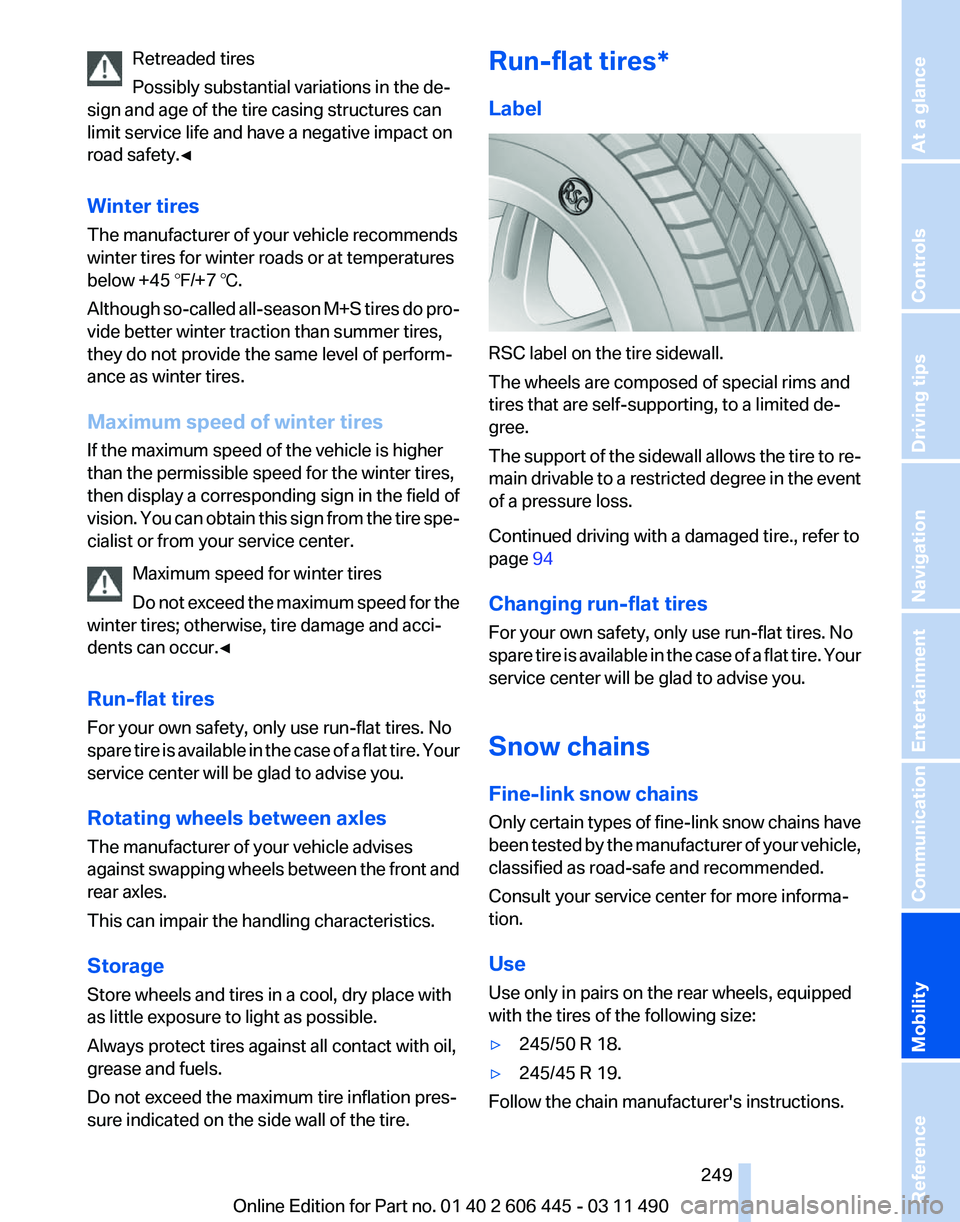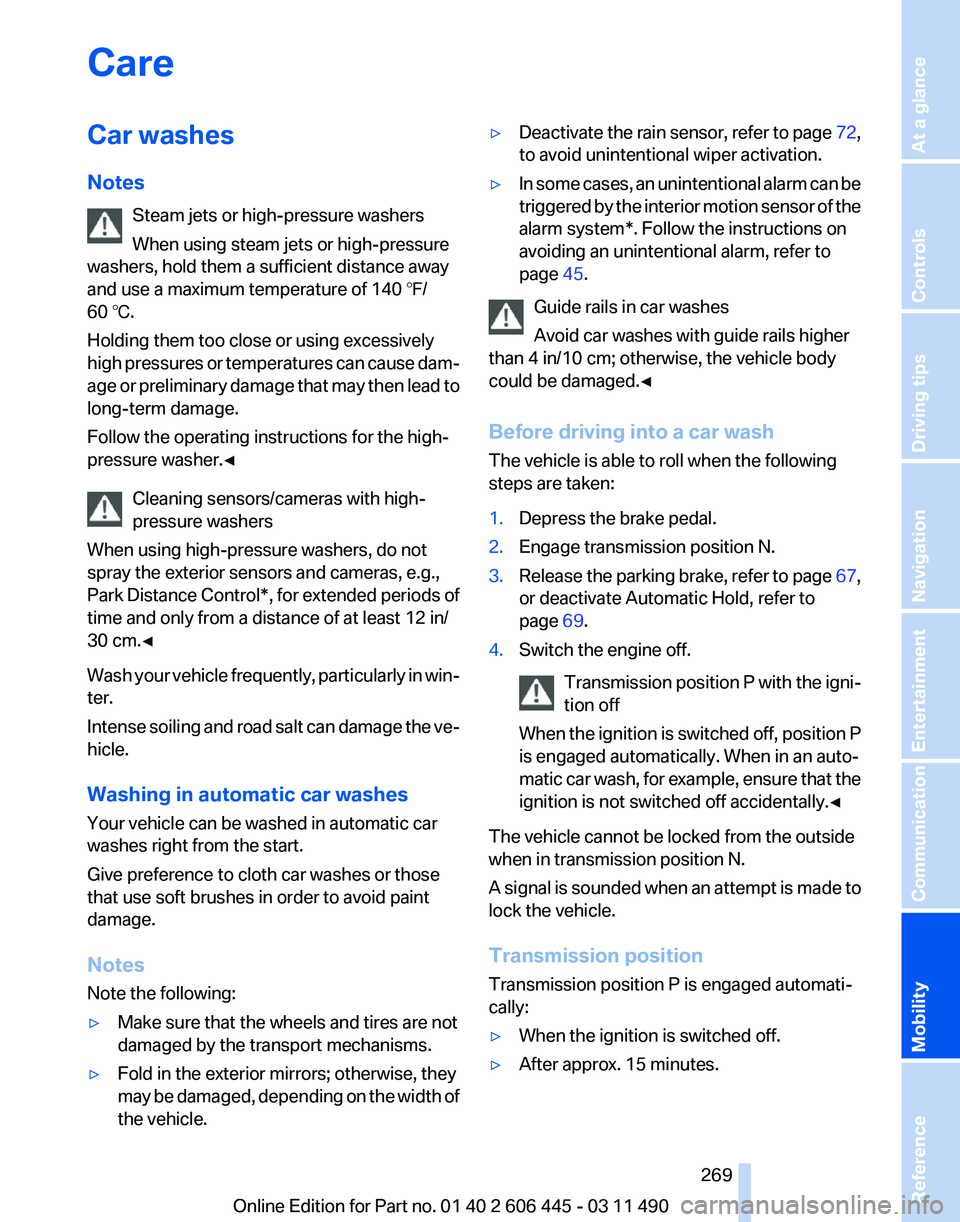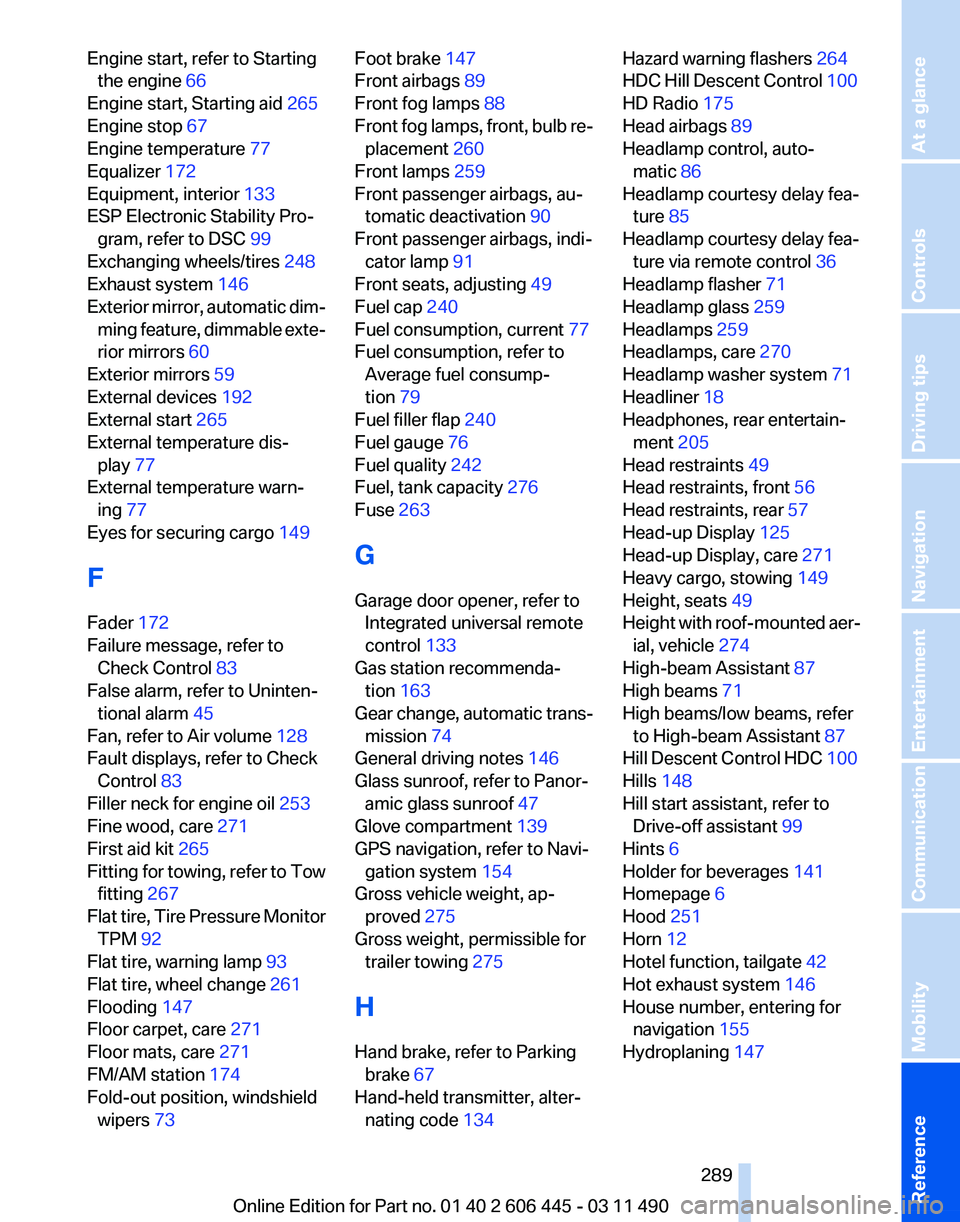2011 BMW 550I XDRIVE GRAN TURISMO low oil pressure
[x] Cancel search: low oil pressurePage 249 of 297

Retreaded tires
Possibly substantial variations in the de‐
sign and age of the tire casing structures can
limit service life and have a negative impact on
road safety.◀
Winter tires
The manufacturer of your vehicle recommends
winter tires for winter roads or at temperatures
below +45 ℉/+7 ℃.
Although
so-called all-season M+S tires do pro‐
vide better winter traction than summer tires,
they do not provide the same level of perform‐
ance as winter tires.
Maximum speed of winter tires
If the maximum speed of the vehicle is higher
than the permissible speed for the winter tires,
then display a corresponding sign in the field of
vision. You can obtain this sign from the tire spe‐
cialist or from your service center.
Maximum speed for winter tires
Do not exceed the maximum speed for the
winter tires; otherwise, tire damage and acci‐
dents can occur.◀
Run-flat tires
For your own safety, only use run-flat tires. No
spare tire is available in the case of a flat tire. Your
service center will be glad to advise you.
Rotating wheels between axles
The manufacturer of your vehicle advises
against swapping wheels between the front and
rear axles.
This can impair the handling characteristics.
Storage
Store wheels and tires in a cool, dry place with
as little exposure to light as possible.
Always protect tires against all contact with oil,
grease and fuels.
Do not exceed the maximum tire inflation pres‐
sure indicated on the side wall of the tire. Run-flat tires*
Label
RSC label on the tire sidewall.
The wheels are composed of special rims and
tires that are self-supporting, to a limited de‐
gree.
The
support of the sidewall allows the tire to re‐
main drivable to a restricted degree in the event
of a pressure loss.
Continued driving with a damaged tire., refer to
page 94
Changing run-flat tires
For your own safety, only use run-flat tires. No
spare tire is available in the case of a flat tire. Your
service center will be glad to advise you.
Snow chains
Fine-link snow chains
Only certain types of fine-link snow chains have
been tested by the manufacturer of your vehicle,
classified as road-safe and recommended.
Consult your service center for more informa‐
tion.
Use
Use only in pairs on the rear wheels, equipped
with the tires of the following size:
▷ 245/50 R 18.
▷ 245/45 R 19.
Follow the chain manufacturer's instructions.
Seite 249
249Online Edition for Part no. 01 40 2 606 445 - 03 11 490
Reference
Mobility Communication Entertainment Navigation Driving tips Controls At a glance
Page 269 of 297

Care
Car washes
Notes
Steam jets or high-pressure washers
When using steam jets or high-pressure
washers, hold them a sufficient distance away
and use a maximum temperature of 140 ℉/
60 ℃.
Holding them too close or using excessively
high
pressures or temperatures can cause dam‐
age or preliminary damage that may then lead to
long-term damage.
Follow the operating instructions for the high-
pressure washer.◀
Cleaning sensors/cameras with high-
pressure washers
When using high-pressure washers, do not
spray the exterior sensors and cameras, e.g.,
Park Distance Control*, for extended periods of
time and only from a distance of at least 12 in/
30 cm.◀
Wash your vehicle frequently, particularly in win‐
ter.
Intense soiling and road salt can damage the ve‐
hicle.
Washing in automatic car washes
Your vehicle can be washed in automatic car
washes right from the start.
Give preference to cloth car washes or those
that use soft brushes in order to avoid paint
damage.
Notes
Note the following:
▷ Make sure that the wheels and tires are not
damaged by the transport mechanisms.
▷ Fold in the exterior mirrors; otherwise, they
may
be damaged, depending on the width of
the vehicle. ▷
Deactivate the rain sensor, refer to page 72,
to avoid unintentional wiper activation.
▷ In some cases, an unintentional alarm can be
triggered
by the interior motion sensor of the
alarm system*. Follow the instructions on
avoiding an unintentional alarm, refer to
page 45.
Guide rails in car washes
Avoid car washes with guide rails higher
than 4 in/10 cm; otherwise, the vehicle body
could be damaged.
◀
Before driving into a car wash
The vehicle is able to roll when the following
steps are taken:
1. Depress the brake pedal.
2. Engage transmission position N.
3. Release the parking brake, refer to page 67,
or deactivate Automatic Hold, refer to
page 69.
4. Switch the engine off.
Transmission
position P with the igni‐
tion off
When the ignition is switched off, position P
is engaged automatically. When in an auto‐
matic car wash, for example, ensure that the
ignition is not switched off accidentally.◀ The vehicle cannot be locked from the outside
when in transmission position N.
A
signal is sounded when an attempt is made to
lock the vehicle.
Transmission position
Transmission position P is engaged automati‐
cally:
▷ When the ignition is switched off.
▷ After approx. 15 minutes. Seite 269
269Online Edition for Part no. 01 40 2 606 445 - 03 11 490
Reference
Mobility Communication Entertainment Navigation Driving tips Controls At a glance
Page 289 of 297

Engine start, refer to Starting
the engine 66
Engine start, Starting aid 265
Engine stop 67
Engine temperature 77
Equalizer 172
Equipment, interior 133
ESP Electronic Stability Pro‐ gram, refer to DSC 99
Exchanging wheels/tires 248
Exhaust system 146
Exterior
mirror, automatic dim‐
ming feature, dimmable exte‐
rior mirrors 60
Exterior mirrors 59
External devices 192
External start 265
External temperature dis‐ play 77
External temperature warn‐ ing 77
Eyes for securing cargo 149
F
Fader 172
Failure message, refer to Check Control 83
False alarm, refer to Uninten‐ tional alarm 45
Fan, refer to Air volume 128
Fault displays, refer to Check Control 83
Filler neck for engine oil 253
Fine wood, care 271
First aid kit 265
Fitting for towing, refer to Tow fitting 267
Flat tire, Tire Pressure Monitor TPM 92
Flat tire, warning lamp 93
Flat tire, wheel change 261
Flooding 147
Floor carpet, care 271
Floor mats, care 271
FM/AM station 174
Fold-out position, windshield wipers 73 Foot brake
147
Front airbags 89
Front fog lamps 88
Front
fog lamps, front, bulb re‐
placement 260
Front lamps 259
Front passenger airbags, au‐ tomatic deactivation 90
Front passenger airbags, indi‐ cator lamp 91
Front seats, adjusting 49
Fuel cap 240
Fuel consumption, current 77
Fuel consumption, refer to Average fuel consump‐
tion 79
Fuel filler flap 240
Fuel gauge 76
Fuel quality 242
Fuel, tank capacity 276
Fuse 263
G
Garage door opener, refer to Integrated universal remote
control 133
Gas station recommenda‐ tion 163
Gear change, automatic trans‐ mission 74
General driving notes 146
Glass sunroof, refer to Panor‐ amic glass sunroof 47
Glove compartment 139
GPS navigation, refer to Navi‐ gation system 154
Gross vehicle weight, ap‐ proved 275
Gross weight, permissible for trailer towing 275
H
Hand brake, refer to Parking brake 67
Hand-held transmitter, alter‐ nating code 134 Hazard warning flashers 264
HDC
Hill Descent Control 100
HD Radio 175
Head airbags 89
Headlamp control, auto‐ matic 86
Headlamp courtesy delay fea‐ ture 85
Headlamp courtesy delay fea‐ ture via remote control 36
Headlamp flasher 71
Headlamp glass 259
Headlamps 259
Headlamps, care 270
Headlamp washer system 71
Headliner 18
Headphones, rear entertain‐ ment 205
Head restraints 49
Head restraints, front 56
Head restraints, rear 57
Head-up Display 125
Head-up Display, care 271
Heavy cargo, stowing 149
Height, seats 49
Height with roof-mounted aer‐ ial, vehicle 274
High-beam Assistant 87
High beams 71
High beams/low beams, refer to High-beam Assistant 87
Hill Descent Control HDC 100
Hills 148
Hill start assistant, refer to Drive-off assistant 99
Hints 6
Holder for beverages 141
Homepage 6
Hood 251
Horn 12
Hotel function, tailgate 42
Hot exhaust system 146
House number, entering for navigation 155
Hydroplaning 147
Seite 289
289Online Edition for Part no. 01 40 2 606 445 - 03 11 490
Reference Mobility Communication Entertainment Navigation Driving tips Controls At a glance